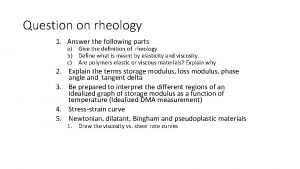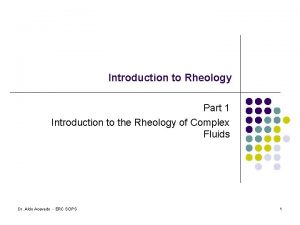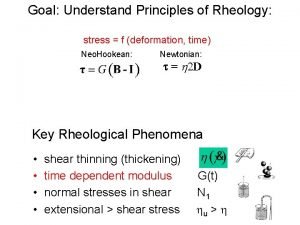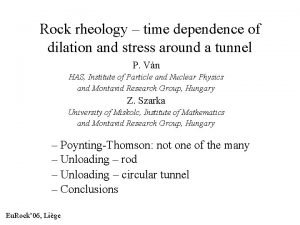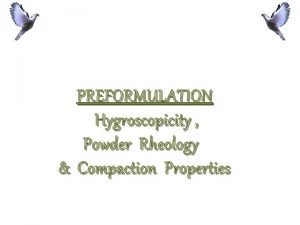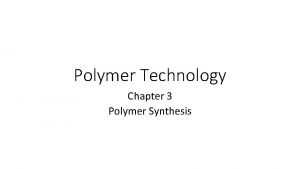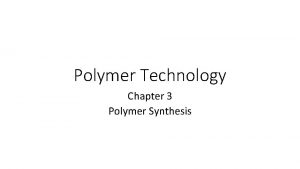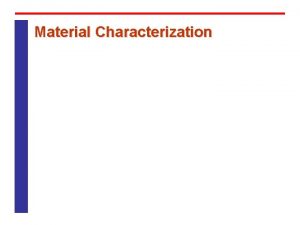Polymer Technology Chapter 12 Polymer Processing and Rheology












- Slides: 12

Polymer Technology Chapter 12 Polymer Processing and Rheology

Polymer Processing and Rheology • Polymer can be processed by varying methods such as extrusion, molding, spinning, calendering, and coating. • Among the specified methods, the extrusion is perhaps the most widely used technique to process the plastics. • Main applications of the extrusion process contain the continuous production of plastic pipe, sheet, and rods. • The molding process is normally a batch process, utilized to process plastic parts as diverse as the cap to a ballpoint pen and a fiber-reinforced bathtub. • The molding process acn be divided into two subgroups: the injection molding operation and the compression molding operation. • Other commercial techniques to process the plastics are the fiber spinning of textiles, the calendering of plastic sheet, and the deposition of organic coatings on plastic sheet.

Polymer Processing and Rheology Extrusion • The extruder, used for the extrusion operation, is composed of a hopper, holding the resin stock in the form of small pellets or powder, and the extruder barrel, which is composed of three main sections on the basis of function. • The mentioned sections are the feed, compression, and metering sections as show in the figure below.

Polymer Processing and Rheology Extrusion • In the feed sectionof the extruder, the solid feed in the solid form is conveyed by the rotating screw from the hopper to the compression zone in which the plastic starts to melt owing to the action of electrical heaters attached to the barrel wall. • Then, the plastic reaches the metering zone, in which all the plastic has melted, and the shearing action of the rotating screw rotating forces the molten plastic to flow through the die. • Finally, the die gives the extrudate the final form.

Polymer Processing and Rheology Extrusion • As an example, a die with an opening in the form of an annulus , which in the form of two concentric cylinders, can be utilized to extrude pipe; a capillary die can be utilized to extrude rods; and a slit die with a rectangular opening can be utilized to extrude sheet. • In addition, a specially designed capillary die can be utilized to coat wire with a layer of plastic insulation. • In commercial plastic processing, the powder form the plastic can be fed directly to the extruder with an opening for venting.

Polymer Processing and Rheology Extrusion • The extruded plastic in the molten state is passed through a capillary die, then cooled, and chopped to form small pellets. • Whe compared with the powder form, the plastics in the pellet shape are easier and safer to handle and they can be shipped, stored, dried, and finally fed into the hopper of another extruder or injection-molding machine to process the final product of the plastic. • The extruders, which are equipped with twin screws , rotating in opposite directions can be utilized when even higher shear rates are needed, as in the case of temperaturesensitive, high-viscosity polymer melts.

Polymer Processing and Rheology Molding • The molding process is one of the earliest and most important processing operations. • This process contains the compression molding operation, the transfer molding operation, the injection molding operation, the reaction injection molding operation, thermoforming molding operation, the blow molding operation, and the rotational molding operation. 1. Compression Molding: Among the specified molding opeartions, the compression molding operation is the least expensive one and the simplest of all other polymer processing operations. • In this molding operation, a certain amount of plastic material is placed into the lower half of a heated mold or cavity. • Then, the plunger is lowered into the cavity, and a specific value of pressure in the range from 20 to 1000 tons is applied to the powder. • Under both heat and pressure, the plastic in the powder fom starts to melt.

Polymer Processing and Rheology Molding Compression Molding • After a certain time interval, the upper mold is opened and the polymer part is ejected. • Then, the polymer part is allowed to cool outside the mold. • The machinery parts of the compression molding operation is relatively simple, which consists of two platens. • The platens of the molding device are brought together. • Then, heat and pressure applied to the mold material to form the part of desired shape. • The platens of the molding instrument can move vertically and the cavity of the molding instrument is usually mounted at the bottom. • Hence, the plastic in the powder or pellet form can be loaded into it on the bottom platen.

Polymer Processing and Rheology Molding TRANSFER MOLDING 2. Transfer Molding: In transfer molding, a certain amount of preheated thermoset material is introduced in a separate or auxiliary heated chamber, which is called the pot. • A plunger is utilized to force the molten material out of the specified pot through the runner system into the closed mold cavity in which the curing reactions take place. • After the plastic material enters into the mold, the air from the mold cavity escapes through vents, which are located strategically on the mold. • After the cure cycle, the entire shot, which contains the gates, runners, sprues, and excess material remaining in the pot , is ejected simultaneously with the molded part of the plastic. • Different form the compression molding, preheating of the plastic material is necessary in transfer molding.

Polymer Processing and Rheology Molding INJECTION MOLDING 3. Injection Molding: A typical injection-molding operation utilizes a reciprocating screw to melt a certain volume of feed introduced through the hopper. • The amount of plastic material, which can be molded, may vary with a particular machine from a few grams to a few kilograms. • A mold with a specific shape needs to be used to obtain a single part like a computer keyboard or several smaller parts simultaneously. • The thick section of the instrument, through which the molten plastic is forced from the nozzle, is called the sprue. • Then, the plastic material in the molten state is pushed through runners. • When the mold is totally filled, it is cooled and opened to release the molded assembly. • Then, the molded parts of the plastics are broken from their attachment.

Polymer Processing and Rheology Molding Reaction injection molding 4. Reaction Injection Molding: The reaction injection molding is a relatively new process, which was developed in Germany during the late 1960 s. With this molding operation, the plastic can be simultaneously synthesized and molded into the final product. • At the beginning of the molding operation, exact quantities of monomers with catalyst and other additives are introduced into a mixing unit and they are forced into the mold, in which the polymerization reactions take place. • Different from the injection molding opeartion, temperatures and clamping pressures in the reaction injection molding opeartion are relatively low, which allows the use of inexpensive aluminum tooling within the reaction injection molding instrument. • Other advantages of the reaction injection molding opeartion contain low energy consumption, rapid start-up time, and its suitability for the production of large shapes like automotive bumpers.

References • Robert O. Ebewele, «POLYMER SCIENCE AND TECHNOLOGY» , CRC Press, 2000. • Fried, Joel R. , «Polymer science and technology» , Prentice Hall, Third edition.
